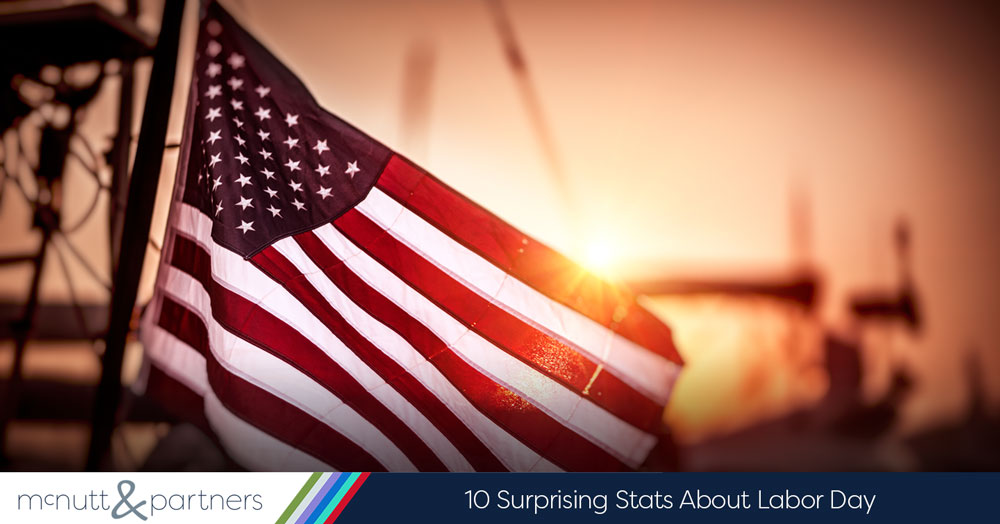If you’re fortunate enough to have shunned your alarm and slept in this morning, you most likely have Labor Day to thank for that. You have a day off of work on a Monday—what else matters? Maybe you’re spending the day jet skiing at the lake. Perhaps you’re getting some work done around the house. Or maybe you’re recovering from the rest of Labor Day weekend. Whatever you’re doing, as you prepare for your Labor Day activities (or lack thereof), take a minute to check out these surprising stats about Labor Day—a holiday signified by widespread retail sales, end-of-summer-celebrations and taking a load off from the daily grind.
- Labor Day competes with the 4th of July and Memorial Day in terms of barbecue consumption. According to umbel.com, more beef is consumed on Memorial Day than any other day of the year, and Labor Day and 4th of July generally tie for second place. Roughly 40 percent of Americans plan to barbecue over Labor Day weekend.
- It’s also a day for dogs. Hot dogs, that is. In addition to the unofficial end of summer, Labor Day is considered the end of hot dog season, according to the National Hot Dog and Sausage Council. Between Memorial Day and Labor Day, Americans eat about 7 billion hot dogs each year.
- And waffles. The first Waffle House opened on Labor Day. The breakfast chain’s first restaurant opened on Labor Day in 1955 in Avondale Estates, Georgia. According to WaffleHouse.com, today there are more than 2,100 locations in 25 states across the United States. Waffle House headquarters is located in Gwinnett County, Georgia, near Norcross.
- People like to get out of town. Whether it’s for that last summer hurrah or a time to take advantage of three days off of work in a row, traveling on Labor Day is a popular trend. Twenty-five percent of Americans plan to leave town on Labor Day, with 86 percent planning to travel by car and 16.1 million Americans planning to fly to their destinations.
- And go to the movies. The top-grossing movie of all time to open on Labor Day weekend was Halloween in 2007, according to Box Office Mojo. The movie grossed nearly $30.6 million on its opening weekend. Halloween is trailed in the rankings by The Possession (2012) and Transporter 2 (2005).
- Others go shopping. A survey of Labor Day consumers showed that the average American will spend approximately $150 during Labor Day weekend shopping. The largest percentage of consumers said it would shop for school supplies (28 percent) followed by clothes (22 percent) and electronics (18 percent).
- The meaning of Labor Day is lost on many. This is evidenced by a 2014 study by Experian that showed that the most popular Labor Day-related search term during that year was “labor day meaning,” followed by “happy labor day images,” “labor day sales,” “labor day history” and then “white after labor day.”
- Speaking of the meaning…Labor Day was established as a creation of the labor movement. The first Labor Day was Sept. 5, 1882 in New York City. The event was sponsored by the Central Labor Union, 10,000 members of which took unpaid time off to march from City Hall to Union Square in New York City to show support for improving poor working conditions and salaries. The federal government did not make Labor Day a federal holiday until 12 years later.
- Speaking of poor working conditions…In the 19th century, the average American worked 12-hour days, seven days a week to make a living. In some instances, children as young as 5 or 6 worked in places like mills, mines and factories while earning a fraction of adults’ wages. Unsafe and unhealthy working conditions coupled with a lack of workers’ rights were the norm.
- But things have changed. Though it varies by age, gender and other factors, the Bureau of Labor Statistics reports that overall, Americans work an average of 38.6 hours per week. The number takes into account workers as young as the 16-19 category, who work an average of 22.6 hours a week. Comparatively, people 20-24 work an average of 36.4 hours a week, ages 25-54 work 42.8 hours a week and ages 55 and older work 40.3 hours a week.
Use these stats about Labor Day help tell the holiday’s story, or store them in your memory bank for a rainy day. From the McNutt & Partners team, happy Labor Day!
For your digital and traditional advertising needs, contact McNutt & Partners today at 324-521-1010 or visit our contact page.

